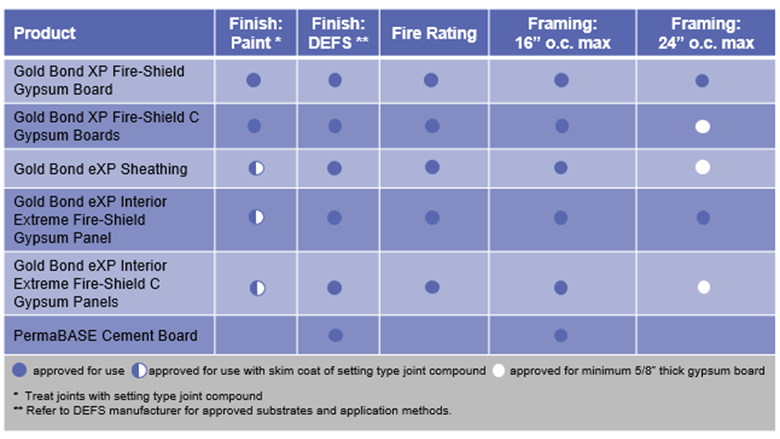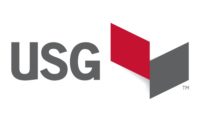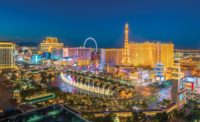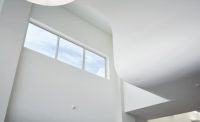Exterior ceiling and soffit areas are common to many building types and require products that are specially formulated to resist sag caused by exposure to excessive heat and humidity. In commercial construction, examples include covered walkways, open parking garages, bank teller drive-through canopies, marquees, or the underside of any upper floor or roof that extends past the exterior wall. Residential applications include breezeways, covered porches and the soffits formed by the eaves of a house.
Historically, gypsum soffit board was used for exterior soffits. This product was distinguished from interior gypsum board by its moisture-repellent paper and special additives for sag resistance. Traditional moisture-resistant gypsum board, or “green board,” utilized wax in the gypsum core to achieve its moisture resistance and was unsuitable for exterior soffits due to its poor sag resistance.
Mold- and moisture-resistant gypsum boards today rely on a different technology for moisture resistance. The paper and gypsum core are treated with silicone, which eliminates the sag problem caused by wax content in older products. As a result, gypsum board products typically specified for wet or semi-wet interior areas, such as Gold Bond XP Fire-Shield Gypsum Board, are also suitable for use in protected exterior soffits, eliminating the need for a separate soffit board product.
Multiple factors should be reviewed when selecting the appropriate gypsum substrate for exterior soffits and ceilings. We recommend that you talk with your Construction Design Manager prior to specifying.
“There are several gypsum board products for soffit applications,” says Scott Hughes, National Gypsum Company Construction Design Manager. “The advantage of having a choice is the possibility of using the same product in the soffit that is already being installed elsewhere on the job. Did you specify mold- and moisture-resistant gypsum board for the interior of the building? Do you have an exterior soffit? Maybe your project requires a fire-shield board for the ability to install the board prior to the building being dried in? In that case, use the same Interior Extreme for the soffits. There’s no reason to have to specify an additional product.”
Your Product Selection Guide for Exterior Soffits and Ceilings
The primary factors you should consider for exterior ceiling and soffit installations are the finish, the fire rating and framing. You may apply some finishes to numerous substrates, such as Direct-applied Exterior Finish Systems, while paint requires special surface treatment for some products.
The Finish
For painted surfaces, use paper-faced, mold- and moisture-resistance gypsum board. You may also use glass-mat faced gypsum panels but some of these products require an additional skim coat of joint compound for a smooth, paintable surface. Use setting-type joint compounds for all exterior joint treatment and skim coat applications. Ready mix products are not approved for exterior use.
You may apply Direct-applied Exterior Finish Systems to some soffit substrates: gypsum boards, gypsum panels or cement boards. So, utilize the products that are already being used on the project and available at the job site. Always consult with the DEFS manufacturer for approved substrates and application methods. We also recommend you talk to your Construction Design Manager before specifying.
Fire-Rated Applications
For applications where the soffit is a component of a fire-rated floor- or roof-ceiling assembly, it is essential to verify that the soffit material is listed in the rated UL design. While some fire-rated assemblies allow for Type X products, most fire-rated floor- and roof-ceiling assemblies require enhanced, proprietary Type X gypsum boards known as Type C gypsum boards. These include gypsum boards and interior Type C gypsum panels.
Framing
For soffit applications, products are applied perpendicular to framing. Apply 1/2-inch gypsum board and 1/2-inch or 5/8-inch PermaBASE cement board to maximum 16-inch o.c. framing. Apply 5/8-inch gypsum board (XP gypsum boards or eXP gypsum panels) to framing up 24-inch o.c.
“There are many things to consider when selecting an appropriate exterior soffit substrate,” said Alan Zeedyk, National Gypsum Construction Design Manager. “Our Construction Design Managers are experienced industry professionals and have seen many different soffit installations. Connect with us and we can help you evaluate product selections based on your specific design requirements.”





Report Abusive Comment